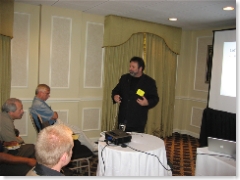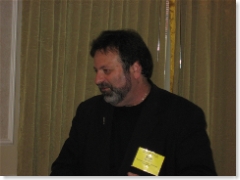 Shel Holtz took us into the world of podcasting. His presentation was titled, Mix Podcasting and PR: How the audio revolution can support clients’ objectives.
Shel Holtz took us into the world of podcasting. His presentation was titled, Mix Podcasting and PR: How the audio revolution can support clients’ objectives.
Podcasting is essentially online downloadable audio which can be received by subscription to an RSS feed.
Although podcasts can be transferred to MP3 players, 56% of people listen at their computer. Recognizing this, an increasing number of podcasts provide their signal on a streaming flash player to enable listening right off the site.
 There are a diverse range of podcast directories that can be used to find content. Podcast Alley. Yahoo. Podshow. However, the cast majority of people who subscribe do so through … iTunes.
There are a diverse range of podcast directories that can be used to find content. Podcast Alley. Yahoo. Podshow. However, the cast majority of people who subscribe do so through … iTunes.
Who listens to podcasts? According to Arbitron, 11% of adults have downlaoded a podcast. 45% of the listenership is aged 35 to 44. They are educated, affluent and trend leders
Podcasts appeal to people who are hungry for niche content.
Podcasting has many advantages:
- It’s time shifted. You can listen when you want. Podcasting is like Tivo for audio.
- It is niche-focused. You can find content that is relevant to your interests. Content that would never be on broadcast radio.
- It is detachable. You can separate it from your computer and listen to it on a portable device (MP3 player).
- Audio can be listened to while you are dong something else. To read a blog, you must be focused on the screen. You shouldn’t do this while driving. But you can listen to a podcast on the train, the plane, in a car, while running, while doing the wash….
- It has low barriers to entry. The easy to use software provides enables anyone to podcast without requiring that they have specialized technical knowledge.
 Podcasting tools are freely available:
Podcasting tools are freely available:
- Audacity Mixing software can be downloaded for free.
- Libsyn.com is a hosting service geared to the needs of podcasters – (e.g. bandwidth, metrics)
Through podcasting, a small company can attach its brand to compelling, interesting content in a way that only large companies could achieve previously through broadcast advertising.
Podcasts should be incorporated into a comprehensive PR program. As part of a program, they can:
- Build brand identity;
- Heighten awareness
- Bolster your reputation
- Build community.
- Educate to build brand affinity.
Shel also offered some secrets for successfulpodcasting
- Unscripted and natural. Podcasts should sound like your authentic, human voice.
- Regular. People like to get into the habit of listening. Reliability counts. Be there when you say you’ll be there.
- No overt selling. Most podcasts do not have advertising. Don’t stand out in a negative way.
- Housed on a blog. A blog provides a place for show notes for every episode, including links mentioned in the show and time codes so that people can find the place they are interested in. Enable comments on the podcast blog and watch the community talk back to you.
- Listener feedback encouraged and incorporated. Incorporate the listener feedback into the show. They will identify even more closely with it.
Shel practises what he preaches. For an example of a successful communications podcast, look at For Immediate Release: The Hobson and Holtz Report, which Shel co-hosts with Neville Hobson.
